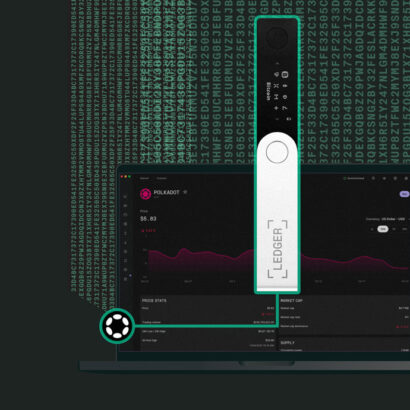There are thousands of different cryptocurrencies, alongside at least a few dozen well-developed blockchains. Many newer blockchain technologies solve specific problems but are costly to validate. Decentralized apps cannot be simultaneously developed for every single blockchain that supports smart contracts because they are disconnected from each other.
Enter Polkadot.
Dr. Gavin Wood, one of the original co-founders of Ethereum, developed Polkadot (DOT) as a solution to the connectivity issue. By connecting these separate blockchains into “parachains”, they can exchange information with each other.
They also allow people staking Polkadot to validate transactions across these parachains. Polkadot also makes it much easier for these smaller blockchains to scale.
Despite only having launched in 2017, Polkadot is already one of the most valuable cryptocurrencies in the world.
Connecting the DOTs
The Problem:
Blockchains are Disconnected
There are dozens of different blockchains, each with different specializations and capabilities. However this makes it a lot harder to develop apps and functionality that work across every single blockchain. Developing Android apps would be much more frustrating if there was a different set of standards and rules for Samsung, LG, Motorola, and Google Phones.
But right now, apps and functionalities can only be deployed within one blockchain ecosystem at a time. If I want to make a decentralized exchange that works on any blockchain, I need to code and test a different app for each blockchain. Joining all of these networks will add functionality to every single blockchain.
The Solution:
Interoperability
If each blockchain is a single dot, then Polkadot simply connects them. Polkadot provides standards for future app development and interoperability across the blockchain.
Imagine only needing to develop one smart contract that can work across the entire ecosystem. Polkadot bridges these separate blockchains, allowing them to work in parallel with the Polkadot blockchain.
In short, a decentralized app could work on Ethereum as well as Solana without requiring any extra code. Because there are always new blockchains, Polkadot would provide a much-needed service to the community. This can also help with scaling blockchain functionality and providing governance through a set of standards to manage upgrades and changes.
A Brief History of Polkadot
One of the co-founders of Ethereum, Dr. Gavin Wood, began toying with the idea of Polkadot in mid-2016, releasing a whitepaper by October of that year. Wood is also the inventor of the Solidity smart contract coding language. Then in 2017, Wood along with Parity’s Peter Czaban founded the Web3 Foundation to support the development of Polkadot.
In October 2017, the Web3 Foundation helped Polkadot raise $145 million in two weeks. Despite much of the funds being stolen, Polkadot was able to continue its technological development. Later, they raised more in a private sale of DOT in June 2019, under a $1.2 billion valuation.
The early version of Polkadot went live in May 2020 after successful proof-of-concept tests, later rolling out Proof of Stake validation as well as methods for governance of the blockchain. Starting at $2.90, the cryptocurrency DOT peaked at more than $47 in May of this year and at the end of September hovered around $26.
The blockchain is still relatively young but as of the end of September 2021, it sits within the Top 10 cryptocurrencies by market cap with a value of over $26 billion. There are also over 340 projects currently being developed for the Polkadot blockchain.
How Does Polkadot Work?
There are two types of blockchains within Polkadot — the Relay chain and Parachains.
The main network itself is called the relay chain while parachains which connect other blockchains to the Relay chain. The relay chain or main network blockchain records permanent transactions and also receives data from parachains.
In a way, parachains are like small rivers that feed into a large ocean or relay network. Any data traveling through the relay network can then visit and exchange information with other parachains. Since the data from parachains will be recorded onto the relay chain, allowing them to benefit from the relay chain’s security and speed. For example, multiple parallel instances of Ethereum can be run, increasing the maximum amount of transactions that can be processed.
That means that by using Polkadot, multiple blockchains could reduce the burden of mining or validation. Rather than needing people to validate transactions on their network, there is one efficient system that validates transactions across multiple blockchains.
Nominated Proof of Stake
This system lets community members vote for the most reliable validators. By nominating a trusted validator with DOT, they back validators with their stake as a sign of good faith. More trusted validators will be nominated with more DOT and thus be able to validate more transactions on the network. This differs from the standard version of
Milestones and Developmental Stages
After years of technical development and testing, the first mainnet launched in May 2020, making quite a splash. Wood’s background gave the project a lot of credibility, attracting investors and app developers alike.
Initially, the mainnet launched in a Proof of Authority mode, with only six official validators. However, as more people bought into the currency, it allowed for Proof of Stake validation. Soon afterward, governance was introduced and the ability to transfer balances was added to the blockchain.
A community referendum in July 2020 inflated DOT’s circulating supply by 100 times through the process of redenomination. Each old DOT token was split into 100 pieces, increasing the supply without changing the market cap, similar to the process of splitting shares in traditional finance. It also made it easier for new investors to buy in, as one token now costs 100 times less than it did before the split.
In January 2021, it entered the coveted Top 5 cryptocurrency by market cap, though it has since slipped out. Currently, more parachains are being rolled out. As of September 28th, 2021 there is a market cap of more than $26 billion with 57,096,228 total tokens. There is no fixed total supply with inflation being paid out to validators that stake their DOT.
The Easiest Way to Buy and Store DOT
The easiest way to get into Polkadot involves buying it on a centralized crypto exchange with USD.
While we don’t advocate for leaving crypto on exchanges for any longer than necessary, you can and should use an exchange to buy crypto like DOT.
Larger exchanges may have slightly higher fees, but they often have proven track records and reliability. Not all are created equal.
We like Coinbase, Kraken and Newton (Canada)
Buy DOT on a reputable crypto exchange:
| Category | Coinbase | Kraken | Newton |
| Official site |  Coinbase |
 Kraken |
 Newton |
| Location | USA | USA | CANADA |
| Ease of use | ★★★★☆ | ★★★★☆ | ★★★★☆ |
| Funding Methods | E-transfer Wire transfer |
Fedwire
SWIFT Etana Custody Silvergate Exchange Network |
Interac e-Transfers
Wire transfers Pre-authorized bank transfers |
| Fees | 1% Flat Fee | Flat 0.9% fee for stablecoins, 1.5% for other cryptos | “Unlike an exchange, we buy from and sell to our users directly, allowing us to capture this price difference.” — Newton |
| Number of Cryptos Supported | 200+ | 185+ | 70+ |
| Trust Score | 10 | 10 | Rated 4.6/5 on Apple App Store 16 K+ Ratings |
| Exchange Trust Score via CoinGecko Not available in all 50 states |
|||

Kraken
Kraken lets you buy 185+ cryptocurrencies including Polkadot.
Get started with as little as $10.
Staking with Kraken gives you the power to earn rewards on your cash and crypto holdings. Start staking in just a couple of clicks and automatically earn rewards twice a week. Instantly unstake at any time with no penalties.
Or you could move it onto your Ledger Nano X. (see below)
| ★★★★☆ |
Storing Polkadot
After you purchase DOT, you have two good options, but the 2nd one might be best:
- Leave it on the Exchange where you bought it
You probably bought your DOT on a central or custodial exchange, so leaving it there might seem reasonable. It’s definitely convenient.
Most exchanges will allow you to earn interest by staking. In our expert opinion, this would be the reason to consider keeping your crypto stored there.
Staking allows you to contribute to the network validation process and earn rewards. In the case of a custodian, they’d stake it for you and pay you a cut of the rewards earned. (up to 14%)
Kraken and Ledger Live will let you stake DOT. - Move it into your own Self-custody Wallet
Moving your DOT to a self-custody wallet comes in two flavors – cold wallets (disconnected from the internet) and hot wallets (have network access).
Cold wallets like Ledger come with the extra step of needing to connect them to a computer before you can sell or use your crypto (DOT). Cold wallets are great for long-term storage of high amounts of any crypto including DOT.
This is a physical hardware wallet that you can plug and unplug from your computer or use bluetooth. It looks like a USB key or a small hard drive. As long as it’s not connected to a computer/network, your crypto is safely stored.
| Category | Exodus | PolkaWallet | Ledger |
| Wallets | 
|

|

|
| Overall rating | ★★★★☆ | ★★★☆☆ | ★★★★☆ |
| Number of Supported Cryptos | 200+ | 200+ | |
| Non-Custodial | Yes | Yes | Yes |
| Staking | Yes (Not available for DOT) |
Yes | Yes |
| Notes | Probably the best wallet for most people, most of the time.
Desktop and mobile apps available. |
Polkawallet is a complete crypto wallet for the Polkadot and Kusama network.
Send, receive and stake assets, and participate in the online community governance. |
Consider Ledger cold storage if you plan to hold your crypto longer term
Ledger Live lets you stake DOT and earn |
| DOT is not currently supported by Trezor. | |||

Ledger
If you’re planning to hold onto DOT for a while you should consider moving it into cold storage. Ledger Nano S and X are your best options because they allow you to stake DOT and earn around 10% APY.
We like the Nano X better because it has more storage, holds more different crypto and is a bit larger and easier to use.
| ★★★★☆ |
The Case for Investing in DOT
Polkadot has arguably one of the greatest launches in the short and tumultuous history of cryptocurrency.
Within less than two years, DOT sits comfortably within the Top 10 cryptocurrencies by market cap and has pulled off many upgrades since the launch of its mainnet back in May 2020.
The mission to connect different blockchains could help integrate transactions between blockchains, improve the scaling by running multiple instances of other blockchains, and providing superior security through the Polkadot relay chain.
Disadvantages of DOT
Like many new cryptocurrencies, DOT has more established competitors. It’s difficult to guess whether DOT could overtake blockchains like Tezos, Cosmos, Cardano, or Ethereum.
Shortly after its initial launch in 2017, hackers exploited the code and drained millions of dollars; this remains a stain on Polkadot’s legacy.
Also, Parachains within the Polkadot ecosystem need to be purchased via auction.
Conclusion
Polkadot is a relatively new cryptocurrency that has already broken through to the Top 10.
With a strong foundational and development team, the rollout of the mainnet has been slow and steady.
Polkadot brings a lot of value to the space as it attempts to standardize the ways that apps and smart contracts are integrated across separate blockchains.
You can stake DOT in a private wallet like Ledger Live, or on an exchange or earn 9—12% by holding DOT on Kraken.
A lot of experienced and successful crypto investors have DOT as in of their portfolio and see it having a bright future.
Bottom line:
Polkadot is close to being a blue chip crypto and certainly worthwhile consideration.
Do your own research.





